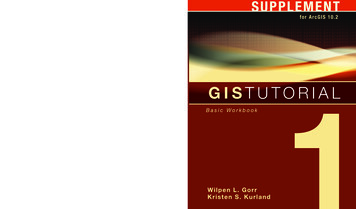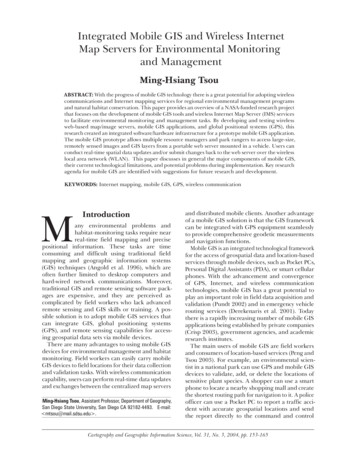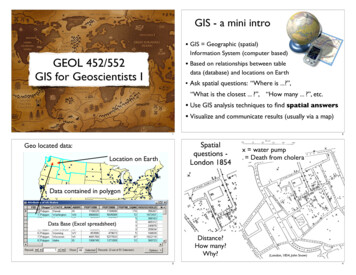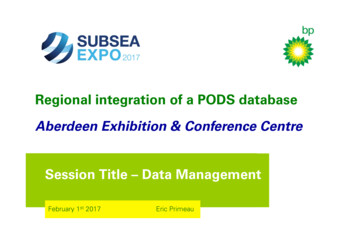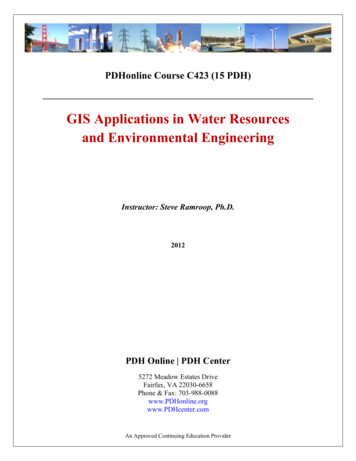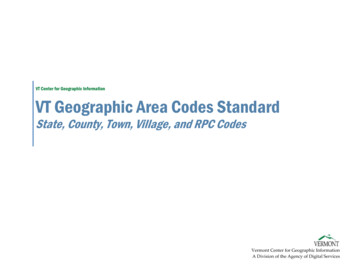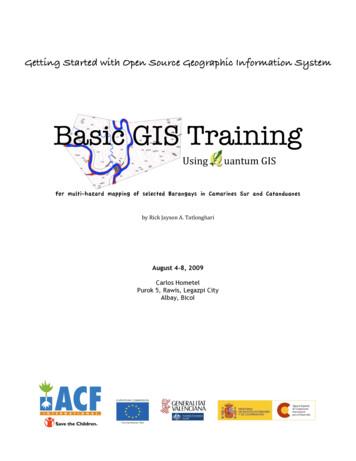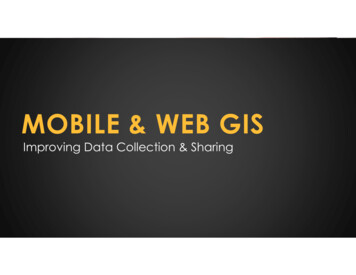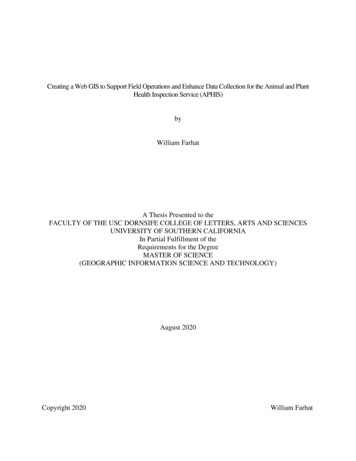
Transcription
Creating a Web GIS to Support Field Operations and Enhance Data Collection for the Animal and PlantHealth Inspection Service (APHIS)byWilliam FarhatA Thesis Presented to theFACULTY OF THE USC DORNSIFE COLLEGE OF LETTERS, ARTS AND SCIENCESUNIVERSITY OF SOUTHERN CALIFORNIAIn Partial Fulfillment of theRequirements for the DegreeMASTER OF SCIENCE(GEOGRAPHIC INFORMATION SCIENCE AND TECHNOLOGY)August 2020Copyright 2020William Farhat
DedicationTo my parents Bill & Carolyn Farhat, for all their continued supportii
AcknowledgementsI would like to thank my thesis advisor, Dr. Bernstein, for all her input while workingthrough this project, as well as my thesis committee members, Dr. Fleming and Dr. Ruddell, forall their input along the way. I would also like to thank Dr. Vos for all his guidance in thebeginning phases of this project. I am especially thankful for the members of APHIS whoprovided data for this project, gave guidance, and participated in testing.iii
Table of ContentsDedication . iiAcknowledgements . iiiList of Tables . viList of Figures . viiAbbreviations . ixAbstract . xChapter 1 Introduction . 11.1. General Statement of Need .21.2. Motivation .31.2.1. Invasive Species and Pest Surveys .31.2.2. Web GIS Needs.51.3. Application Overview .71.3.1. Intended Users .71.3.2. Study Area .81.3.3. Application Use .81.3.4. Application Design .9Chapter 2 Related Research . 112.1. Web GIS.112.1.1. Operations Dashboard .112.1.2. Data Collection .122.2. Database Design.122.3. Forest Pests .132.3.1. Role of GIS .132.3.2. Trapping .142.4. Related Applications .142.4.1. APHIS Access Database .142.4.2. Trapview .162.4.3. EDDMapS Pro .162.5. Summary .16Chapter 3 Application Development . 183.1. Requirements .183.1.1. Application Goals .183.1.2. User Requirements .183.1.3. Functional Requirements .193.1.4. Interagency Operations and the Public .193.2. Data .203.2.1. Illinois Protected Lands .21iv
3.2.2. Gap Land Cover .223.2.3. APHIS Access Database and Synthetic Data Creation .243.3. Database Design.323.3.1. Creating an Enterprise Geodatabase .323.3.2. Creating Feature Classes and Tables .333.3.3. Creating Relationships between Feature Classes and Tables .343.3.4. Adding Domains and Subtypes.343.3.5. Symbology .373.3.6. Backend Data Processing .393.3.7. Publishing Services to ArcGIS Server .403.4. Collector and Operations Dashboard Design .403.4.1. Creation of Web Map and Consuming Feature Services .413.4.2. Symbology and Pop-ups .413.4.3. Collector .453.4.4. Operations Dashboard .463.5. User Feedback .47Chapter 4 Results . 494.1. Application Overview .494.1.1. Collector for ArcGIS.494.1.2. Operations Dashboard .534.2. End User Workflows.594.2.1. Pest Survey Specialist (PSS) and Field Operations Supervisor (FOP) .604.2.2. Field Technicians .614.3. Application Evaluation and Testing.634.3.1. Subjects .634.3.2. Survey Design .644.3.3. User Feedback .64Chapter 5 Conclusions . 735.1. Application Summary .735.2. Discussion .745.3. Challenges in Development .755.4. Limitations of Project .765.5. Applicability for Other Projects .775.6. Future Work .79References . 82Appendices . 85Appendix A User Needs Interview. 85Appendix B Subsites and Synthetic Data . 91Appendix C Activities Synthetic Data . 93Appendix D User Testing Survey. 96v
List of TablesTable 1. Datasets . 20Table 2. Site Table . 28Table 3. Site Symbology Question #1 . 69Table 4. Site Symbology Question #2 . 69Table 5. Subsite Symbology Question #1 . 70Table 6. Additional feedback . 71vi
List of FiguresFigure 1. APHIS Access Database Form . 15Figure 2. Illinois Protected Lands in Cook County . 21Figure 3. Land Uses in Cook County, IL . 23Figure 4. Land Cover Polygon Model . 24Figure 5. Front-end forms in APHIS Database . 25Figure 6. APHIS Access database diagram . 26Figure 7. Entity-Relationship Diagram of Relevant Tables in Application. 27Figure 8. Geocoding and Buffer Model . 29Figure 9. Sites and Subsites in Northern Cook County . 30Figure 10. Sites and Subsites in Southern Cook County . 31Figure 11. Create Enterpise Geodatabase Tool. 32Figure 12. Create Database User Tool . 33Figure 13. Database Properties dialog showing Domain Values . 35Figure 14. Subtypes for Subsite Feature Class . 36Figure 15. Symbology for Subsites and Sites in Cook County, IL . 37Figure 16. Symbology for Base Layers . 38Figure 17. Code Values and Code Snippet . 39Figure 18. Symbology for Subsite layer based on SurveyStatus . 41Figure 19. Web Map displaying labels for sites and subsites . 43Figure 20. Pop-up displaying days since last visit . 44Figure 21. Collector Setting for Related Types . 45Figure 22. Operations Dashboard Sidebars . 46vii
Figure 23. Collector Overview . 50Figure 24. Adding Data in Collector. 51Figure 25. Adding an Asian Gypsy Moth Subsite . 52Figure 26. Adding a New Asian Gypsy Moth Activity . 53Figure 27. Operations Dashboard Overview . 54Figure 28. Making a Selection in the Dashboard . 55Figure 29. Dashboard Sidebar for Sites and Subsites . 56Figure 30. Web Map with Data Editing Capabilities . 57Figure 31. Editing Data within Subsite Popup. 58Figure 32. Exporting Data from the Dashboard. 59Figure 33. Web GIS Workflow for PSS and FOP . 60Figure 34. Web GIS Workflow for Field Technicians . 62Figure 35. Daily Task Responses. 65Figure 36. User Satisfaction of the Operations Dashboard. 66Figure 37. User Satisfaction of Collector . 66Figure 38. Difficulty of the Application . 67Figure 39. Adequacy of Supplemental Datasets . 68Figure 40. Usefulness of Site Symbology. 68Figure 41. Usefulness of Subsite Symbology . 70viii
AbbreviationsUSDAUnited States Department of AgricultureAPHISAnimal and Plant Health Inspection ServicePPQPlant Protection and QuarantineEWBBExotic Wood-boring BeetlesAGMAsian Gypsy MothGISGeographic Information SystemAGOLArcGIS Onlineix
AbstractInvasive insects are damaging to the environment and economy. Early detection of these pests isimportant to prevent their establishment before their populations grow and cause extensivedamage. In the United States, the Animal and Plant Health Inspection Service (APHIS)safeguards natural resources and agriculture through their Plant Protection and Quarantine (PPQ)program by preventing the establishment and entry of forest pests into the United States. APHIStraps exotic wood-boring beetles (EWBB) and other pests. Throughout all the APHIS officesacross the United States, there is no unified field data collection method. As of 2019, the APHISoffice in Chicago, IL uses Microsoft Access for all their field data collection. The main objectiveof this thesis is to build a Web GIS with mobile data collection capabilities and an operationsdashboard to further monitor data collection in the field. Collector for ArcGIS can be used formobile data collection in the field and an operations dashboard can help supervisors monitorfield operations more effectively. This project utilized a user needs interview with members ofthe APHIS team in Chicago to guide application development. The developed Web GISapplication, which includes an operations dashboard and Collector for ArcGIS, was then testedby users of APHIS to determine whether their workflows would benefit. The application waswell received by users and the feedback helped to uncover a few notions that could guide furtherdevelopment of this application in the future. These enhance APHIS’s current workflow throughreal-time data collection as well as more accurate data collection. The completed applicationcould also be used in rural areas where less high-risk importers are present throughcustomization. Approximately 80% of the application would remain the same, though therewould be changes in the symbology and data collection layers. This could benefit APHIS offices,as well as other organizations monitoring invasive pest control.x
Chapter 1 IntroductionThe Animal and Plant Health Inspection Service (APHIS) conducts various surveys for forestpests that are known to cause extensive damage to the agricultural industry and forested areas.Many of their field operation surveys involve trapping of these forest pests for early detection.As of 2019, current data collection methods involve pen and paper field records and enteringdata into Microsoft Access. Connecting their database structure to a Web GIS (GeographicInformation System) could enable more efficient field data collection as well as more thoroughmonitoring of trapping and pest detection. Field technicians could enhance their daily workflowswith a data collection app with more automated field collection and field supervisors could moreeffectively manage their teams using an operations dashboard. Using a data collection app withdatasets of forested areas and canopy cover type, technicians could more effectively place trapsfor more efficient early detection of forest pests. Storing APHIS’s database in Microsoft’s SQLServer could streamline data collection with the use of ArcGIS Server and ArcGIS Online(AGOL).The main objective of this project is to build a Web GIS that enables the use of anoperations dashboard and Collector for ArcGIS. These applications can enhance 2019methodsused for field data collection as well as having more practical data storage. A Web GIS couldalso provide many opportunities such as data analysis, story maps, data collection, and datasharing between agencies through AGOL.The rest of Chapter 1 is divided into three different sections. Section 1.1 gives a generalstatement of need for the application. Section 1.2 describes the overall motivation for thisapplication. Finally, Section 1.3 discusses the general overview of the application.1
1.1. General Statement of NeedAPHIS’s duties include plant pest management of invasive species, early detection ofexotic pests, and protecting American agriculture from pests (Lance 2003). APHIS conductsseveral types of surveys for presence of forest pests near high-risk areas such as industrial areasor railroads that contain wood packing material. The most common pathways for introduction ofexotic pests is through trade of live plants and wood material (Liebhold et al. 2012). Woodmaterial mainly includes pallets, which invasive pests can bore into and be transported into theUnited States. Surveys for pest detection involve setting up numerous traps with target-specificlures to attract pests in high-risk areas. Traps baited with lures assist in early detection of exoticwood-boring pests (Brockerhoff et al. 2006). Forested areas are common places for traps as pestsare attracted to a wide variety of tree species.As of 2019, APHIS stores all their data in a Microsoft Access database which containsaddresses of high-risk importers, and past trap locations. Entering trap information into thedatabase involves writing down coordinates along with other information in the field andentering them into Access in the office. The APHIS workflow could benefit from a databaseformat that supports AGOL functionality. Connecting their Access database to a Web GIS(Geographic Information System) can provide more efficient data collection and bettermanagement of field operations. ArcGIS Online can provide many opportunities for moreefficient data collection in the field with the use of an Operations Dashboard and Esri’s Collectorfor ArcGIS (to be referred to as “Collector” from here on).2
1.2. MotivationThis section discusses the general motivation for creating this application and is dividedinto two different subsections. First, Subsection 1.2.1 discusses the impact of invasive species inthe environment. Subsection 1.2.2 further discusses the need for a Web GIS.1.2.1. Invasive Species and Pest SurveysIn the United States, invasive species cause almost 120 billion in damages every year(Pimentel, Zuniga, and Morrison 2004). Invasive species incur great damage in the environmentas well as the economy due to the costs of managing them. Invasive species are hard to manageonce they become established due to lack of natural predators to control them (Pimental, Zuniga,and Morrison 2004 ).Early detection is often the most cost-effective management solution to keeping invasivespecies under control. Epanchin-Niell et al. (2016) concluded that a trapping program for earlydetection is very cost-effective and can provide net present benefits over a 30-year plan. Byputting up traps in high risk areas, APHIS can prevent establishment of forest pests. A trapallows for APHIS to become aware of the presence of pests so that they can respondappropriately and potentially mitigate the spread of forest pests.Once established, forest pests cause destruction in the environment and economy becausethey are very costly to manage. Therefore, early detection is very important. A Web GIS thatcombines pest surveys can provide for more efficient data collection with less errors. More timecan be spent doing surveys, which could lead to more effective management and early detectionof these pests. The following sections discuss the different types of invasive species that APHISmonitors through surveys in further detail.3
1.2.1.1. Exotic Wood-boring Beetles SurveyExotic wood-boring beetle (EWBB) trapping is one of the main surveys that APHISconducts for early detection of these pests. Trade between countries leads to the spread of EWBBthrough wood packing material such as pallets (Haack 2006). Wood packing material is thevector of travel for many EWBB such as bark beetles and longhorn beetles, the main target taxaof APHIS EWBB Surveys. APHIS is made aware of their presence through a reporting system.Emergency Action Notifications (EANs) are issued in this system which provides addresses ofhigh-risk importers (Magarey, Colunga-Garcia, and Fieselmann 2009). These are issued based onimporters not following proper regulations such as fumigation protocol and other treatments.Surveying for EWBB is important because it can help APHIS understand which importers arenot following proper protocols and mitigate the spread of EWBB.1.2.1.2. Asian Gypsy Moth SurveyThe Asian Gypsy Moth (AGM) is another forest pest that APHIS conducts surveys for.AGM is a defoliator that attacks oak tree species. Unlike the European Gypsy Moth (EGM),AGM can fly further distances and attack a wider range of host trees (Gibbons 1992). As withEWBB, early detection is also important. Surveying is required to develop an understanding ofthe distribution of AGM, as well as EGM. Trapping involves setting up a delta trap with a lurethat attracts AGM. Going unchecked, AGM can cause extensive damage in forests and cause aloss of biodiversity due to the many organisms that rely on oak species.1.2.1.3. Cerceris SurveyThe last main survey is for Buprestid beetles, such as the Emerald Ash Borer (EAB).EAB is a very destructive EWBB that attacks Ash trees and has destroyed millions of ash trees inNorth America (Herms and McCullough 2014). Traditional trapping methods are not used for4
monitoring of buprestids. Instead, the Cerceris Fumipennis wasp, a natural predator, is used tomonitor buprestid populations. Cerceris wasps prefer hard sandy soil such as baseball diamondsto make their nests and they often drop their prey next to their nests (Swink, Paiero, and Nalepa2013). This technique is known as biosurveillance and can be an excellent tool to monitor earlydetection and establishment of buprestids.1.2.2. Web GIS NeedsThis section discusses the need for a Web GIS for APHIS and the potential benefits. It isdivided into three sections which include connection to Web GIS, data collection, and operationsdashboards.1.2.2.1. Connection to a Web GISAPHIS’s Access database does not have a connection to ArcGIS. If any analyzing orviewing of the data needs to be done, it must be exported as a table and opened in ArcMap orGoogle Earth. This would be problematic if there were ever a new forest pest introduced intoIllinois, as no real-time system would be in place to monitor a huge operation. The normal fieldoperations would have to be scaled up to include more trap locations and more techniciansduring an emergency. Having an organized system already in place can avoid inefficiencies andconfusion. Without Web GIS, the alternative would be paper maps and manually entering datainto the Access database.1.2.2.2. Data CollectionData collection in the field using Collector can allow for more accurate data collection aswell as saving time. Recording data manually is often labor-intensive and can introduce errors(Vivoni and Camilli 2003). Pen and paper methods often result in errors when copying down5
coordinates. Coordinates may be written down wrong and entered into the database incorrectlyback in the office. There is also a lot of information that is needed depending on the survey type.The Cerceris survey requires information about the baseball diamonds and nest count. Atechnician may check over a dozen baseball fields in one day and the information about eachfield may be written down incorrectly or forgotten about.Once pest detection traps are installed, they are serviced every two weeks. Collector hasthe capability to allow records of related tables to be linked to a feature class. This could allowfor field technicians to view a recent history of work performed on the trap such as a lure changeor a sample being taken. This could cut out a lot of time that is spent writing down all thisinformation. It could also ensure that a lure is changed when it has expired. With moreinformation available, fewer mistakes would be made.The availability of real-time data is especially important for the Cerceris Biosurveillancesurvey. This survey involves going out to different baseball diamonds in search of Buprestiddrops from the Cerceris wasp. If more than one technician is in an area, it is possible that theycould have crossed paths and visited diamonds that have already been checked that day. This canquickly turn into a very inefficient and redundant process. Without an application that shows realtime site visits performed, field technicians are at the mercy of a log of visits only available inthe office and relying on their coworkers to enter visits in a timely manner. A more automated,real-time collection could eliminate these inefficiencies.1.2.2.3. Operations DashboardMonitoring of traps could be more effective with real-time data, allowing for supervisorsto better assess the spread of the infestation. Operations dashboards can give supervisors a betteridea of the day-to-day operations and identify problems or concerns (Edwards et al. 2015). An6
operations dashboard would be useful for showing statistics on traps that have been serviced andinformation about positive identifica
for more efficient early detection of forest pests. Storing APHIS's database in Microsoft's SQL Server could streamline data collection with the use of ArcGIS Server and ArcGIS Online (AGOL). The main objective of this project is to build a Web GIS that enables the use of an operations dashboard and Collector for ArcGIS.
